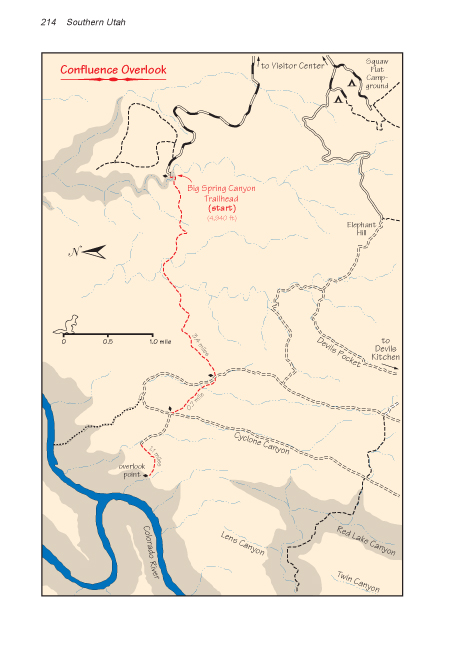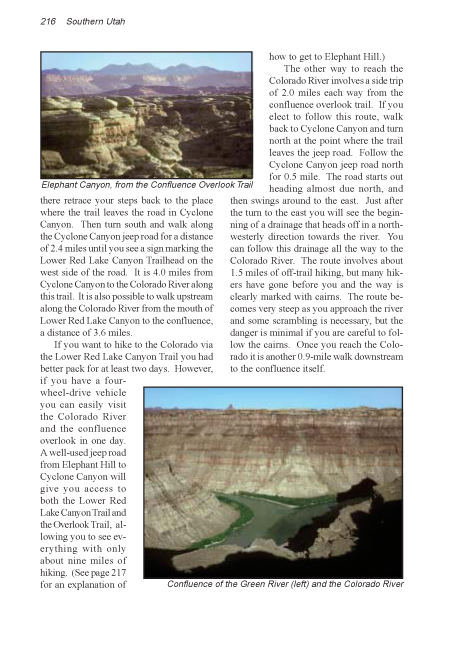|
Links to other sites:
Do you have any recent information to add about this trail?
Ordering books & Maps
Free sample copies of Outdoor Magazines
Comments about this site or our book:

|
Canyonlands, the largest of
Utah’s five national parks, is neatly split into thirds
by the intersection of the Green and the Colorado Rivers. Both
rivers have carved thousand-foot-deep canyons through the high
surrounding desert, and the view of their confluence at the center
of the park is one of Canyonlands’ most impressive sights.
Both of the famous rivers have
now been largely tamed by a series of dams built over the last
sixty years, but from this prospective one can still see the
same wild scene that John Wesley Powell saw during his historical
voyage down the Green and Colorado Rivers in 1869. In July of
that year, while his party was camped on the north side of the
confluence, Powell and one of his men climbed above the rivers
to a point just south of the present day overlook trail. In the
following passage, first printed in Scribner’s Monthly in
1875, Powell describes what he saw:
"From the north-west came the Green in a narrow, winding
gorge. From the north-east came the Grand [Colorado] through
a canyon that seemed, from where we stood, bottomless.... Wherever
we looked there was a wilderness of rocks- deep gorges where
the rivers are lost below cliffs, and towers, and pinnacles,
and ten thousand strangely carved forms in every direction, and
beyond them mountains blending with the clouds." (The
Canyons of the Colorado, reprinted by Outbooks, Golden, Colorado,
1981)
From the trailhead the trail
immediately drops into Big Spring Canyon, and then climbs up
the other side. This is really the only strenuous part of the
route, but it doesn’t last long. Big Spring Canyon is only
120 feet deep at this point. After leaving Big Spring Canyon
the trail meanders pleasantly across the open desert for another
3.1 miles before crossing a jeep road at the northern end of
another shallow canyon called Devils Lane. After another 0.7
mile the trail crosses the road again as the road doubles back
into Cyclone Canyon. At the point where the trail meets the jeep
road the second time you will see another spur road branching
off to the west. The trail continues down this road.
After walking west on the spur
road for 0.6 miles you will come to a dead end, where there is
a small outhouse and a parking area for jeeps. A Park Service
sign points the way to the trail that will lead you the last
0.5 mile to the overlook point.
The Colorado River
After seeing the rivers from the
overlook point, many hikers feel a great urge to descend into
the canyon to the shore of the Colorado. There are at least two
ways to do this. Three if you include Powell’s route below
the overlook point, but I would hardly recommend his route. It
is quite exposed and requires some rock climbing skills. (Amazingly,
Powell did it with only one arm! He had lost his right arm 7
years earlier in the Civil War.)
The easiest way to get to the Colorado
River is on the Lower Red Lake Canyon Trail, which descends from
Cyclone Canyon 3.5 miles south of the overlook. To get there
retrace your steps back to the place where the trail leaves the
road in Cyclone Canyon. Then turn south and walk along the Cyclone
Canyon jeep road for a distance of 2.4 miles until you see a
sign marking the Lower Red Lake Canyon Trailhead on the west
side of the road. It is 4.0 miles from Cyclone Canyon to the
Colorado River along this trail. It is also possible to walk
upstream along the Colorado River from the mouth of Lower Red
Lake Canyon to the confluence, a distance of 3.6 miles.
If you want to hike to the Colorado
via the Lower Red Lake Canyon Trail you had better pack for at
least two days. However, if you have a four-wheel-drive vehicle
you can easily visit the Colorado River and the confluence overlook
in one day. A well-used jeep road from Elephant Hill to Cyclone
Canyon will give you access to both the Lower Red Lake Canyon
Trail and the Overlook Trail, allowing you to see everything
with only about nine miles of hiking. (See page 204 for an explanation
of how to get to Elephant Hill.)
The other way to reach the Colorado
River involves a side trip of 2.0 miles each way from the confluence
overlook trail. If you elect to follow this route, walk back
to Cyclone Canyon and turn north at the point where the trail
leaves the jeep road. Follow the Cyclone Canyon jeep road north
for 0.5 mile. The road starts out heading almost due north, and
then swings around to the east. Just after the turn to the east
you will see the beginning of a drainage that heads off in a
northwesterly direction towards the river. You can follow this
drainage all the way to the Colorado River. The route involves
about 1.5 miles of off-trail hiking, but many hikers have gone
before you and the way is clearly marked by cairns. The route
becomes very steep as you approach the river and some scrambling
is necessary, but the danger is minimal if you are careful to
follow the cairns. Once you reach the Colorado it is another
0.9 mile walk downstream to the confluence itself. |

